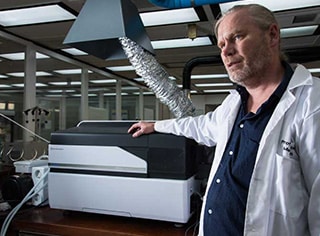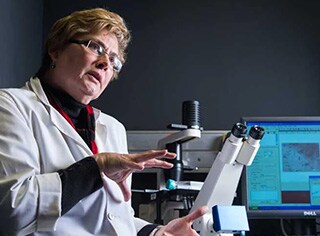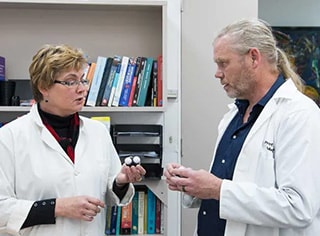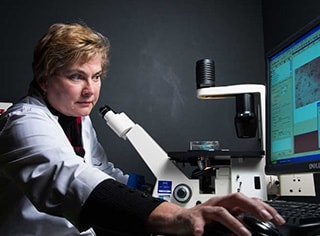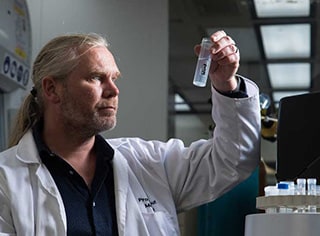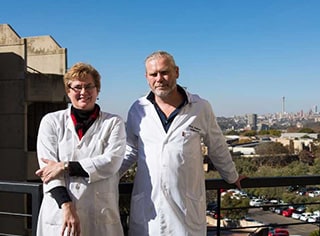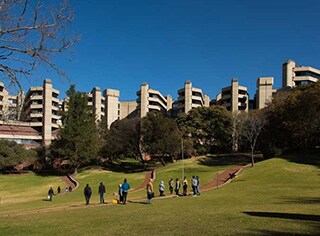Worth its weight in gold, costs its weight in silver

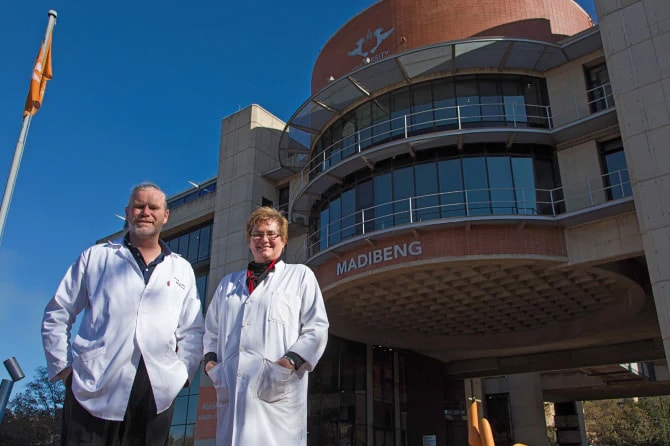
Series: MOMENTUM
Cancer is a disease that afflicts all people and all nations, but in Africa it is low on the list of medical priorities. Despite this handicap, by working with Shimadzu, Dr. Marianne Cronjé and Dr. Reinout Meijboom have developed a silver-phosphine compound that kills cancer cells, giving hope to a new, cheap drug.

After investing in their education up to university, many African nations are resigned to watch their best minds move to academic institutes abroad. It is estimated that a majority of African countries see more than 20% of educated professionals leave their home country.1 Rare is the scientist who moves the other way. Dr. Reinout Meijboom is a rare scientist.
It is at the University of Johannesburg, where he holds the title of Professor at the Department of Chemistry, Meijboom met Professor Marianne Cronjé, a cancer researcher and head of the Department of Biochemistry. Meijboom is a chemist who never cared for medical research until meeting Cronjé. Together, however, the two have been studying the effects of silver-based compounds on cancer cells. One compound in particular, UJ3, has received international recognition for its anti-cancer effects. Using Shimadzu equipment, they aim to modify this compound into a drug that can potentially save countless lives around the world.
Meijboom was born in Haren, Netherlands, and remained there through to his graduation until he moved to Cape Town, South Africa, to earn his Ph.D.
“I had visited Cape Town as a student and I just thought the beaches looked good,” he says.
Cronjé is also from the Netherlands, born in Gouda, eponymous for its cheese, but had moved to South Africa when she was two years old. However, neither their shared Dutch heritage nor their research was the main reason the they became friends.
“Reinout’s wife is a lecturer at [my] department. We’ve been colleagues and friends since they started here at the University of Johannesburg. We were visiting socially. I had started my anti-cancer projects, and Reinout was talking about these compounds,” Cronjé says.
A needle in a haystack
“These compounds” are silver-phosphine complexes that had caught Meijboom’s attention a couple of years before arriving in Johannesburg.
“I started playing with silver in 2005 or 2006 because I noticed a tremendous gap in the literature about silver-phosphine chemistry,” he says. “I was interested in the crystallographic properties of these compounds, because if you use a different ratio of silver to phosphine you get a completely different compound coming out. The starting materials are pretty cheap and there is tremendous opportunity to do some research there”.2
To Meijboom, silver-phosphine complexes were a purely scientific endeavour, but to Cronjé they had anti-cancer implications.
“I was looking for a niche area in my cancer work. When Reinout was speaking about these complexes, I said, ‘Let’s just test them.’”
There is a long history of metal-based compounds having anti-cancer effects. Cisplatin is a platinum-based drug that targets dividing cells like cancer. It was first synthesized in the 1800s, but its medical use only began in the 1970s. Now it is commonly used in chemotherapy, but comes with severe side-effects because it targets all replicating cells, not just cancerous ones. There is a history too of gold having positive effects in the laboratory, but failed toxicology studies have prevented these compounds from becoming mainstream.
Silver is attractive because it is by far the least expensive of the three. It also is known to have anti-microbial properties and was aggressively researched nearly a century ago as a treatment for various illnesses. Those studies were shelved, however, when they revealed side-effects that patients found intolerable, explains Dr. Riaan Meyer, Vice President of Shimadzu South Africa.
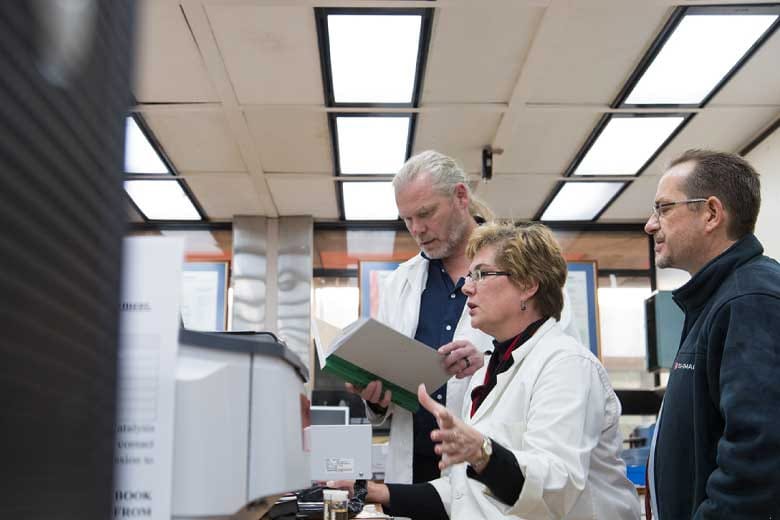
“Silver fell out of favour because most patients did not appreciate walking around with blue faces,” he says.
Phosphine, on the other hand, is an inorganic nonmetal found in most human tissues, but it too has toxic properties.3 The history of its effects in cancer can be traced to the 1980s.4 However, the first report of silver-phosphine complexes having anti-cancer effects was only published in 1998.5
Since collaborating, Cronjé and Meijboom have tested a series of Meijboom’s silver-phosphine complexes on different cancer cells. These complexes differed in their ratio of silver to phosphine and the type of organic groups attached to the phosphine.6,7
“There are about 3000 different compounds, and we’re nowhere near making all of them,” says Meijboom.
In fact, they have only synthesized about 200 compounds and tested 25 of them on cancer cell lines. One of them , UJ3, was found to have a remarkable effect on all cancer lines tested, including a line made from an African patient with esophageal cancer, killing the cells with remarkable efficiency while leaving other cells relatively unharmed.8
“We stepped on a needle in a haystack,” says Meijboom, adding that this surprising early hit only gives more legitimacy to exploring the long list of silver-phosphine complexes still to be synthesized, “but that does not mean there are not more needles.”
Cronjé admits that the success has all been a big surprise. “I can’t really say, ‘I thought it would work.’ It was completely serendipitous.”
The ideal cancer drug
There are two ways in which a cell can die. One is apoptosis, which describes programmed cell death and is a natural phenomenon that eliminates cells that have served their purpose or cells that are not functioning properly. In general, apoptosis is a checkpoint that prevents unnecessary or unwanted cells from replicating or consuming the body’s energy. Indeed, one common outcome of failed apoptosis is cancer.
The other way a cell can die is through necrosis. Here, a disease or infection causes cell death. In apoptosis, complex machinery in the body is available to dispose the cell. In necrosis, the remnants of the dead cell fester like contaminants. It is the difference between having your tooth wiggle and fall out when you are seven years old or having it yanked out by the dentist because of a grotesque cavity. In the former, the tooth will loosen on its own harmlessly while waiting for its replacement to grow. In the latter, there is a risk of infection spreading to other teeth.
The ideal cancer drug is one that activates apoptosis and activates it in cancer cells only.
Cronjé and Meijboom are certain that UJ3 exerts its anti-cancer effect by activating apoptosis. It enters the cancer cell, where it then targets the mitochondria, which are the energy factories of the cell. At the biochemical level, Meijboom and Cronjé found that UJ3 stimulates mitochondria to secrete the molecule cytochrome C into the cell cytoplasm. There, cytochrome C activates the protein caspase-3, a key factor in the activation of apoptosis.
Excitingly, this apoptotic effect is seen at one tenth the dose needed to get the same results using cisplatin. The low dose and high specificity suggest that UJ3 has far less of the side-effects common to chemotherapies. Even at high doses, early tests on animals suggest that UJ3 has no adverse effects.
“That normally does not happen, that a compound is selective for cancer cells. That’s when we looked at different permutations, different combinations,” says Cronjé, describing the different ratios and organic groups used in the synthesis of silver-phosphine complexes.
What Meijboom and Cronjé cannot discern is why UJ3 preferentially targets cancer cells. There is no clear reason that explains how UJ3 permeates the membrane and then the mitochondria of cancer cells more easily than of other cells.
“We think it is because of the energetics of the mitochondria,” says Cronjé. Cancer cells, because they replicate at a much faster rate than healthy cells, consume much more energy, which requires more active mitochondria and other changes in the cell. Why UJ3 can recognize these changes requires a great deal more study.
This is where the two scientists imagine their relationship with Shimadzu could be a real boost.
Partnering with Shimadzu
Even though South Africans have a higher cancer mortality rate than people in the United States, Europe or Japan, it is a much lower medical priority than in those other places.9
“Funding is a challenge. In Africa, HIV, AIDS and tuberculosis have received the bulk of funding. Probably second to that is malaria. Cancer deserves a lot of attention, but it is not currently Africa’s biggest crisis,” says Cronjé.
Even the Technology Innovation Agency (TIA) of South Africa, a public organization whose purpose is to support basic research that shows promising results for the clinic, had been hesitant to invest in the promise of silver-phosphine complexes.
“They originally had serious doubts about funding. Drug discovery is very high risk,” says Cronjé. “However, once we had presented compelling evidence that the compounds, and in particular UJ3, could selectively induce apoptosis in cancer cells, TIA committed to three cycles of funding.”
Meyer says that Shimadzu too has been encouraged by the research results and is eager to help Cronjé and Meijboom develop their product.
“The novel synthesis of this class of compounds and the potential it showed towards a cure to cancer interested us at Shimadzu South Africa,” he says.
Meijboom notes that unlike other companies, which hire third parties in the region, Shimadzu has its own office and own employees in Johannesburg. The nearby presence of Shimadzu staff creates a collaborative environment that is natural to academic researchers.
“Shimadzu is unique in South Africa. Every other company has a company representing them. Shimadzu does that directly,” he says.
As one example, Shimadzu is considering how to bring its imaging mass microscope into the project. This instrument combines optical imaging with mass spectroscopy, allowing the researchers to observe the distribution of specific molecules, such as UJ3, cytochrome C, and caspase 3, in the cells.
“We like to bounce ideas off each other. ‘How do we do this? How do we do that?’ Shimadzu does beta tests. We exchange ideas,” says Cronjé. “One of the questions I have received is, ‘Can we label UJ3 with a fluorescent marker and see where it ends up?’”
Visualizing how UJ3 enters the cells and then identifying the molecules with which it interacts would give clues on new cancer targets and invite modifications to the experimental compound to enhance its specificity and efficacy.
Shimadzu’s commitment reached a new level in April 2018, when Shimadzu CEO Teruhisa Ueda visited the university to describe his plans for Shimadzu’s future in the country. Cronjé was excited to hear the proposal, stating that it would add to unique strengths the university has for cancer research.
“Africa is a treasure trove of medicinal plants that should be explored and some of them already been shown to have anti-cancer activity. We have excellent facilities here at UJ. A Centre of Excellence (formally called “Shimadzu Africa Innovation Centre”) would be the first for Africa, not just South Africa. It would be tremendous.”
Meijboom says that better facilities and training would have an impact that goes well beyond cancer.
“We get very well trained early-career students and these people will probably stay in South Africa and build the economy.”
* Affiliates and titles of the persons mentioned in this article reflect their status at the time of the interview.
* Contents in this article are based on information available to us at the time of writing (August 2018).
References
-
Capuano, S. & Marfouk, A. (2013). African Brain Drain and Its Impact on Source Coauntries: What Do We Know and What Do We Need to Know? Journal of Comparative Policy Analysis: Research and Practice 15, 297-314.
-
Meijboom, R. et al. (2009). Coordination complexes of silver(I) with tertiary phosphine and related ligands. Coordination Chemistry Reviews 253, 325-342.
-
Information., N. C. f. B. PubChem Compound Database; CID=24404,.
-
Berners-Price, S. J. & Sadler, P. J. Phosphines and metal phosphine complexes: Relationship of chemistry to anticancer and other biological activity. (Springer Berlin Heidelberg, 1988).
-
McKeage, M. J. et al. (1998). Antitumor Activity of Gold(I), Silver(I) and Copper(I) Complexes Containing Chiral Tertiary Phosphines. Metal-Based Drugs 5, 217-223.
-
Ferreira, E. et al. (2015). The effect of 1:2 Ag(I) thiocyanate complexes in MCF-7 breast cancer cells. Biometals 28, 765-781.
-
Human, Z. et al. (2015). The induction of cell death by phosphine silver(I) thiocyanate complexes in SNO-esophageal cancer cells. Biometals 28, 219-228.
-
Engelbrecht, Z. et al. (2018). The ability of silver(I) thiocyanate 4-methoxyphenyl phosphine to induce apoptotic cell death in esophageal cancer cells is correlated to mitochondrial perturbations. Biometals 31, 189-202.
-
Cancer Research UK. Worldwide cancer mortality statistics.
 Copied
Copied


